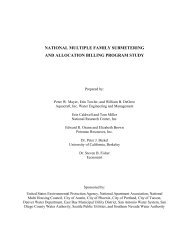Sustainable Insight: Water Scarcity – A dive into global ... - KPMG
Sustainable Insight: Water Scarcity – A dive into global ... - KPMG
Sustainable Insight: Water Scarcity – A dive into global ... - KPMG
- No tags were found...
Create successful ePaper yourself
Turn your PDF publications into a flip-book with our unique Google optimized e-Paper software.
2 | <strong>Sustainable</strong> <strong>Insight</strong>: <strong>Water</strong> <strong>Scarcity</strong> – A <strong>dive</strong> <strong>into</strong> <strong>global</strong> reporting trendsIn briefIn this edition of <strong>KPMG</strong>’s <strong>Sustainable</strong> <strong>Insight</strong> we explore how the world’s majorbusinesses are setting out their approaches to water scarcity via their keycommunication vehicles on corporate responsibility (CR) and sustainability. 1We investigate what they are reporting on and – sometimes more importantly –what they are not reporting on, and we draw out significant variances betweensectors and geographic regions.The enlightening results suggest that while most companies are at least paying lipservice to the issue in their reports, far fewer are presenting a convincing picture ofa thorough and robust response to the challenge.Reading this paper will help executives understand what best practice lookslike; how – and why – they should improve their company’s response to waterscarcity; and how they can communicate that response more effectively to theirstakeholders.We conclude with ten key questions designed to help executives develop andcommunicate strategic responses to the water scarcity challenge.Introduction<strong>Water</strong> scarcity has risen to the top of the corporate agenda over the past few years.In the face of dire predictions about dwindling supplies, a growing number ofbusinesses are taking measures to become better stewards of this vital resource.The momentum has been catalyzed, in part, by the immediate and tangible threatthat water scarcity poses. Global demand for freshwater will exceed supply by40 percent by 2030, according to the <strong>Water</strong> Resources Group, with potentiallycalamitous implications for business, society and the environment. Whencompared with the more gradual and indirect implications of climate change, waterscarcity seems not only a more immediate issue, but also a more manageable one.Like other sustainability megaforces, water scarcity brings both risks andopportunities for businesses. Diminishing water supplies can disrupt – or evencurtail – business operations, power generation capacity and the supply of keybusiness inputs. Simply put: no water, no products, no business.<strong>Water</strong> scarcity also brings about a number of indirect impacts. Governments arealready introducing regulations to manage supplies more effectively which, in turn,are creating new compliance requirements and/or cost increases for businesses.For example, in 2008, the Portugese government introduced a tax on major waterusers in agriculture and industry. More recently, in June 2012, China announced thatit will adopt high water rates for water-intensive industries and will encourage thereuse of recycled water. 2 And Singapore’s regulators have priced water to reflect itsscarcity value.1Sources for this paper were CR and sustainability reports, annual financial reports and corporate websites.2http://news.xinhuanet.com/english/china/2012-06/22/c_131669919.htm.© 2012 <strong>KPMG</strong> International Cooperative (“<strong>KPMG</strong> International”), a Swiss entity. Member firms of the <strong>KPMG</strong> network of independent firms are affiliated with <strong>KPMG</strong> International. <strong>KPMG</strong> International provides no client services. All rights reserved.
















